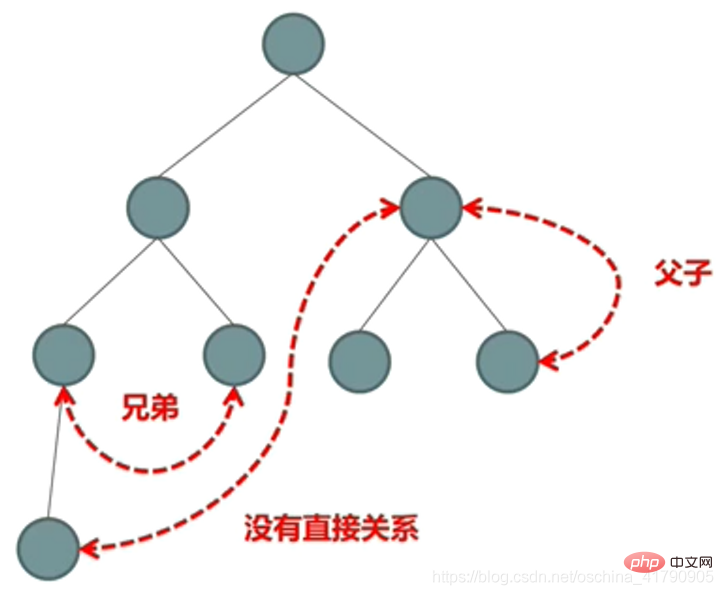本篇文章带大家详细了解一下Angular中组件间通讯的几种。有一定的参考价值,有需要的朋友可以参考一下,希望对大家有所帮助。

Angular 组件间的通讯
组件间三种典型关系:
父好组件之间的交互(@Input/@Output/模板变量/@ViewChild)
非父子组件之间的交互(Service/localStorage)
还可以可以利用 Session、 路由参数来进行通讯等
相关教程推荐:《angular教程》
父子组件之间交互
子组件编写
- child.component.ts
@Component({
selector: 'app-child',
templateUrl: './child.component.html',
styleUrls: ['./child.component.css']
})
export class ChildComponent implements OnInit {
private _childTitle = '我是子组件';
@Input()
set childTitle(childTitle: string) {
this._childTitle = childTitle;
}
get childTitle(): string {
return this._childTitle;
}
@Output()
messageEvent: EventEmitter<string> = new EventEmitter<string>();
constructor() { }
ngOnInit(): void {
}
sendMessage(): void {
this.messageEvent.emit('我是子组件');
}
childFunction(): void {
console.log('子组件的名字是:' + this.childTitle);
}
}- child.component.html
<div class="panel panel-primary">
<div class="panel-heading">{{childTitle}}</div>
<div class="panel-body">
<button (click)="sendMessage()" class="btn btn-success">给父组件发消息</button>
</div>
</div>父组件
- parent-and-child.component.ts
@Component({
selector: 'app-parent-and-child',
templateUrl: './parent-and-child.component.html',
styleUrls: ['./parent-and-child.component.css']
})
export class ParentAndChildComponent implements OnInit {
constructor() { }
ngOnInit(): void {
}
doSomething(event: any): void {
alert(event);
}
}- parent-and-child.component.html
<div class="panel panel-primary">
<div class="panel-heading">父组件</div>
<div class="panel-body">
<app-child #child (messageEvent) = "doSomething($event)"></app-child>
<button (click)="child.childFunction()" class="btn btn-success">调用子组件的方法</button>
</div>
</div>@Input 属性绑定是单向的,父组件的属性变化会影响子组件的属性变化, 子组件的属性变化不会反过来影响父组件的的属性变化。
不过,可以利用 @Input() 和 @Output() 实现属性的双向绑定。
@Input() value: string; @Output() valueChange: EventEmitter<any> = new EventEmitter(); // 实现双向绑定 <input [(value)] = "newValue"></input>
注意: 使用 [()] 进行双向绑定时,输出属性名必须是输入属性名与 Change 组成, 形如: xxxChange。
非父子组件之间交互
使用 Service 进行交互
- event-bus.service.ts
/**
* 用于充当事件总线
*/
@Injectable()
export class EventBusService {
evnetBus: Subject<string> = new Subject<string>();
constructor() { }
}- child1.component.ts
@Component({
selector: 'app-child1',
templateUrl: './child1.component.html',
styleUrls: ['./child1.component.css']
})
export class Child1Component implements OnInit {
constructor(private eventBusService: EventBusService) { }
ngOnInit(): void {
}
triggerEventBus(): void {
this.eventBusService.evnetBus.next('child1 触发的事件');
}
}- child1.component.html
<div class="panel panel-primary">
<div class="panel-heading">child1 组件</div>
<div class="panel-body">
<button (click)="triggerEventBus()" class="btn btn-success">触发事件</button>
</div>
</div>- child2.component.ts
@Component({
selector: 'app-child2',
templateUrl: './child2.component.html',
styleUrls: ['./child2.component.css']
})
export class Child2Component implements OnInit {
events: Array<string> = new Array<string>();
constructor(private eventBusService: EventBusService) { }
ngOnInit(): void {
this.listenerEvent();
}
listenerEvent(): void {
this.eventBusService.evnetBus.subscribe( value => {
this.events.push(value);
});
}
}- child2.component.html
<div class="panel panel-primary">
<div class="panel-heading">child2 组件</div>
<div class="panel-body">
<p *ngFor="let event of events">{{event}}</p>
</div>
</div>- brother.component.ts
@Component({
selector: 'app-brother',
templateUrl: './brother.component.html',
styleUrls: ['./brother.component.css']
})
export class BrotherComponent implements OnInit {
constructor() { }
ngOnInit(): void {
}
}- brother.component.html
<div class="panel panel-primary">
<div class="panel-heading">第二种:没有父子关系的组件间通讯</div>
<div class="panel-body">
<app-child1></app-child1>
<app-child2></app-child2>
</div>
</div>使用 localStorage 进行交互
- local-child1.component.ts
@Component({
selector: 'app-local-child1',
templateUrl: './local-child1.component.html',
styleUrls: ['./local-child1.component.css']
})
export class LocalChild1Component implements OnInit {
constructor() { }
ngOnInit(): void {
}
writeData(): void {
window.localStorage.setItem('message', JSON.stringify({name: 'star', age: 22}));
}
}- local-child1.component.html
<div class="panel panel-primary">
<div class="panel-heading"> LocalChild1 组件</div>
<div class="panel-body">
<button class="btn btn-success" (click)="writeData()">写入数据</button>
</div>
</div>- local-child2.component.ts
@Component({
selector: 'app-local-child2',
templateUrl: './local-child2.component.html',
styleUrls: ['./local-child2.component.css']
})
export class LocalChild2Component implements OnInit {
constructor() { }
ngOnInit(): void {
}
readData(): void {
const dataStr = window.localStorage.getItem('message');
const data = JSON.parse(dataStr);
console.log('name:' + data.name, 'age:' + data.age);
}
}- local-child2.component.html
<div class="panel panel-primary">
<div class="panel-heading">LocalChild2 组件</div>
<div class="panel-body">
<button class="btn btn-success" (click)="readData()">读取数据</button>
</div>
</div>- local-storage.component.ts
@Component({
selector: 'app-local-storage',
templateUrl: './local-storage.component.html',
styleUrls: ['./local-storage.component.css']
})
export class LocalStorageComponent implements OnInit {
constructor() { }
ngOnInit(): void {
}
}- local-storage.component.html
<div class="panel panel-primary">
<div class="panel-heading">第三种方案:利用 localStorge 通讯</div>
<div class="panel-body">
<app-local-child1></app-local-child1>
<app-local-child2></app-local-child2>
</div>
</div>最后,关于使用 Session、路由参数实现数据交互的方式,这里就不演示了。
更多编程相关知识,请访问:编程视频!!
以上是详解Angular中组件间通讯的几种方法的详细内容。更多信息请关注PHP中文网其他相关文章!
 JavaScript的角色:使网络交互和动态Apr 24, 2025 am 12:12 AM
JavaScript的角色:使网络交互和动态Apr 24, 2025 am 12:12 AMJavaScript是现代网站的核心,因为它增强了网页的交互性和动态性。1)它允许在不刷新页面的情况下改变内容,2)通过DOMAPI操作网页,3)支持复杂的交互效果如动画和拖放,4)优化性能和最佳实践提高用户体验。
 C和JavaScript:连接解释Apr 23, 2025 am 12:07 AM
C和JavaScript:连接解释Apr 23, 2025 am 12:07 AMC 和JavaScript通过WebAssembly实现互操作性。1)C 代码编译成WebAssembly模块,引入到JavaScript环境中,增强计算能力。2)在游戏开发中,C 处理物理引擎和图形渲染,JavaScript负责游戏逻辑和用户界面。
 从网站到应用程序:JavaScript的不同应用Apr 22, 2025 am 12:02 AM
从网站到应用程序:JavaScript的不同应用Apr 22, 2025 am 12:02 AMJavaScript在网站、移动应用、桌面应用和服务器端编程中均有广泛应用。1)在网站开发中,JavaScript与HTML、CSS一起操作DOM,实现动态效果,并支持如jQuery、React等框架。2)通过ReactNative和Ionic,JavaScript用于开发跨平台移动应用。3)Electron框架使JavaScript能构建桌面应用。4)Node.js让JavaScript在服务器端运行,支持高并发请求。
 Python vs. JavaScript:比较用例和应用程序Apr 21, 2025 am 12:01 AM
Python vs. JavaScript:比较用例和应用程序Apr 21, 2025 am 12:01 AMPython更适合数据科学和自动化,JavaScript更适合前端和全栈开发。1.Python在数据科学和机器学习中表现出色,使用NumPy、Pandas等库进行数据处理和建模。2.Python在自动化和脚本编写方面简洁高效。3.JavaScript在前端开发中不可或缺,用于构建动态网页和单页面应用。4.JavaScript通过Node.js在后端开发中发挥作用,支持全栈开发。
 C/C在JavaScript口译员和编译器中的作用Apr 20, 2025 am 12:01 AM
C/C在JavaScript口译员和编译器中的作用Apr 20, 2025 am 12:01 AMC和C 在JavaScript引擎中扮演了至关重要的角色,主要用于实现解释器和JIT编译器。 1)C 用于解析JavaScript源码并生成抽象语法树。 2)C 负责生成和执行字节码。 3)C 实现JIT编译器,在运行时优化和编译热点代码,显着提高JavaScript的执行效率。
 JavaScript在行动中:现实世界中的示例和项目Apr 19, 2025 am 12:13 AM
JavaScript在行动中:现实世界中的示例和项目Apr 19, 2025 am 12:13 AMJavaScript在现实世界中的应用包括前端和后端开发。1)通过构建TODO列表应用展示前端应用,涉及DOM操作和事件处理。2)通过Node.js和Express构建RESTfulAPI展示后端应用。
 JavaScript和Web:核心功能和用例Apr 18, 2025 am 12:19 AM
JavaScript和Web:核心功能和用例Apr 18, 2025 am 12:19 AMJavaScript在Web开发中的主要用途包括客户端交互、表单验证和异步通信。1)通过DOM操作实现动态内容更新和用户交互;2)在用户提交数据前进行客户端验证,提高用户体验;3)通过AJAX技术实现与服务器的无刷新通信。
 了解JavaScript引擎:实施详细信息Apr 17, 2025 am 12:05 AM
了解JavaScript引擎:实施详细信息Apr 17, 2025 am 12:05 AM理解JavaScript引擎内部工作原理对开发者重要,因为它能帮助编写更高效的代码并理解性能瓶颈和优化策略。1)引擎的工作流程包括解析、编译和执行三个阶段;2)执行过程中,引擎会进行动态优化,如内联缓存和隐藏类;3)最佳实践包括避免全局变量、优化循环、使用const和let,以及避免过度使用闭包。


热AI工具

Undresser.AI Undress
人工智能驱动的应用程序,用于创建逼真的裸体照片

AI Clothes Remover
用于从照片中去除衣服的在线人工智能工具。

Undress AI Tool
免费脱衣服图片

Clothoff.io
AI脱衣机

Video Face Swap
使用我们完全免费的人工智能换脸工具轻松在任何视频中换脸!

热门文章

热工具

螳螂BT
Mantis是一个易于部署的基于Web的缺陷跟踪工具,用于帮助产品缺陷跟踪。它需要PHP、MySQL和一个Web服务器。请查看我们的演示和托管服务。

EditPlus 中文破解版
体积小,语法高亮,不支持代码提示功能

ZendStudio 13.5.1 Mac
功能强大的PHP集成开发环境

安全考试浏览器
Safe Exam Browser是一个安全的浏览器环境,用于安全地进行在线考试。该软件将任何计算机变成一个安全的工作站。它控制对任何实用工具的访问,并防止学生使用未经授权的资源。

SublimeText3 Mac版
神级代码编辑软件(SublimeText3)






